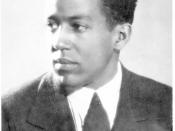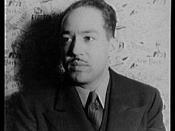Starting in the 1920s, over one million African-Americans moved out of the oppressive southern states which they had always known and flooded into the northern states. The majority of them settled down in the city of Harlem, New York. These black migrants were searching and hoping to gain the social status and privileges which had been denied to them all across the south. From this group of blacks, a generation of well-educated poets, novelists, playwrights, painters, essayists, and musicians emerged. They focused on African-American culture in their works and aroused a sense of kinship, togetherness, racial pride and a true independence among blacks in America. This artistic and literary movement, from post World War I until the 1930's, is known today as the Harlem Renaissance. Langston Hughes, a poet of the Harlem Renaissance, described this period in American history as a time when, "the Negro was en vogue." (Ojo-Ade 45).
The Harlem Renaissance was a period of creative expression among blacks in America with literary artists like Langston Hughes, Zora Neale Hurston, Claude McKay, and Countee Cullen representing the prolific and talented writes of the time.
Certain separate events which happened at the same time in history resulted in the Harlem Renaissance. The rising curiosity of white intellectuals about the lives of oppressed people living in colonies of other nations, such, as Cuban revolutionaries, led toward an increased interest of these intellectuals on the people who were oppressed here in the United States, like the blacks and the Native Americas. Previous to the Renaissance, black literary artists found a publisher for their work to be unattainable. Through the increased notice of affluent intellectuals in African-American work, blacks found sponsors with the wealth and community status to get them published. Furthermore, the "Roaring Twenties" was an era of social rebellion,


